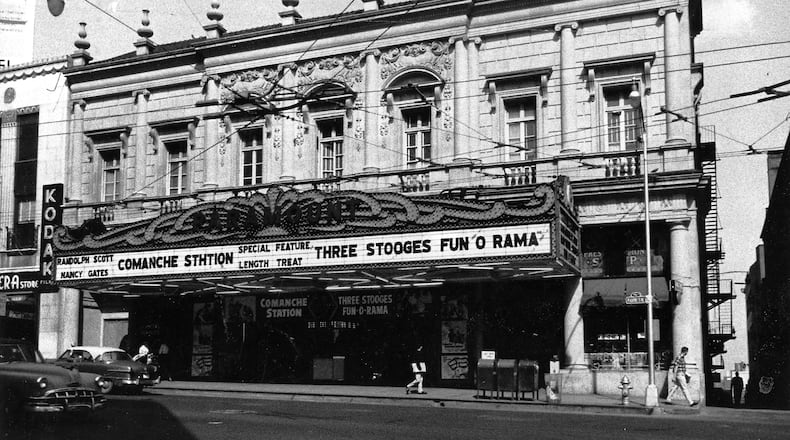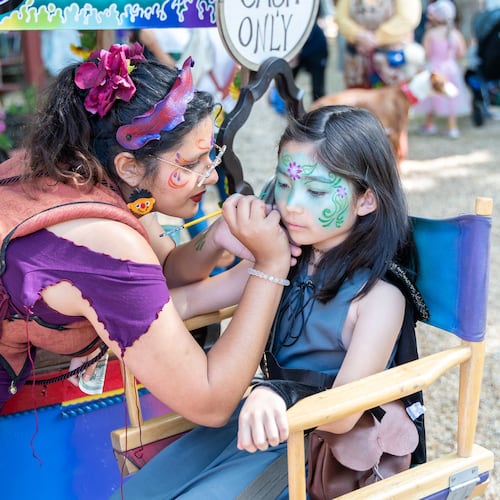NOTE: This story originally published on Nov. 22, 2015.
The decade of the 1940s was arguably the height of Atlanta’s era of movie palaces. Theaters were still clumped together in entertainment districts, or anchored for the city’s independent neighborhoods. Soon the city would spread further out and televisions would move into residents’ living rooms, gradually sending most of these businesses into decline. Some would find new life, and some would crumble to the ground. Here’s a survey of some of those theaters, with information taken from the 1940 city directory, and from the CinemaTreasures.org website (http://www.CinemaTreasures.org) and its hive mind of commenters.
The Loew’s Grand first opened as an opera house. The Loew’s is most famous for hosting the 1939 premiere of “Gone With the Wind.” It was badly burned in 1978 and later became the site of the Georgia-Pacific Building. The photo above was taken in 1952.
The Paramount Theatre sat next to the Loew’s Grand, and is mostly remembered for its elaborate facade, designed by architect Philip Trammell Shutze, who also designed the Swan House and the Rich’s Department Store. The theater was demolished in 1960, but the top part of the facade lives on as the front of a mansion in Moultrie, Ga.
The Plaza Theatre: Georgia’s oldest operating movie theater opened in 1939 and continues to accept your hard-earned dollars. Don’t let the longevity fool you however — the theater has had its ups and downs, including a turn in the 1970s as a porn palace. Since the early 1980s it’s been an art house theater owned by cinephile entrepreneurs such as George Lefont and Jonathan & Gayle Rej. The latest owner, Michael Furlinger, has done extensive renovations to the building, including an overhaul of the neon marquee, with the help of the Fox Theatre Institute. In 2014, the Plaza was named the fifth best movie theater in the world by Men’s Journal.
Credit: Charles Pugh
Credit: Charles Pugh
Bailey’s Eighty-One Theatre: This theater was at Decatur Street and Central Avenue, at the intersection diagonal from today’s Walter’s Clothing. The Bailey’s chain served Black audiences during the decades of segregation, and if comments on CinemaTreasures.org are any indication, the Eighty-One Theatre was probably the best remembered of the Bailey’s locations.
Bailey’s Ashby Theatre: Many of the Bailey’s locations in 1940 were in the small retail blocks of the city’s Black neighborhoods. This location on MLK Jr. Drive, near the Atlanta University Center, still features the theater’s marquee, and is one of the only ones that still stand. UPDATE: In 2020, the dilapidated theater, which still retains its distictive marquee, was placed on the Georgia Trust for Historic Preservation’s list of 10 Places in Peril.
The Roxy Theatre: First opened on Peachtree Street as the Georgian Theatre, but is best known as the Roxy. It was demolished in 1972 when the Westin Peachtree Hotel was built. Don’t confuse it with the Coca-Cola Roxy in Buckhead, which is now called the Buckhead Theatre.
The Capitol Theatre: The Capitol sat right next door to the Roxy on Peachtree Street. It was built after its more famous neighbor and was gone earlier. It’s seen here in 1944. Unlike the Roxy however, the building that the Capitol resided in is still there — 200 Peachtree (the former downtown Macy’s Building). The theater was housed where Meehan’s Public House is today.
The Fox Theatre: Our city’s most famous grand theater opened in 1929 and continues to show movies — in the summer, at least. After a near-death experience in 1975, it rose from the ashes and vowed never to be hungry again. How Atlanta.
The Madison Theatre: This theater on Flat Shoals Road in East Atlanta was built in 1929, the same year as the Fox Theatre. It’s been vacant for decades, but there have been rumblings in recent years that it might eventually get restored.
The Rialto Theatre: This theater opened as the Piedmont Theatre in 1916, and changed its name to the Rialto the same year. The photo above was taken in 1951. The theater was razed and rebuilt in 1962, then closed in 1989. It got renovated a few years later and reopened in 1996 as the Rialto Center for the Performing Arts, as part of the GSU campus.
The Hilan Theatre: The Hilan in Virginia Highland operated as a theater from 1939 to 1969. Since then, it has been a church and a bank, and a host of retail establishments, including Starbucks and Ben & Jerrys.
The Rhodes Theatre likely opened around 1937, when the Rhodes Center shopping district opened around and across from historic Rhodes Hall in Midtown. The photo above is from 1944. Commenters on CinemaTreasures.org remember the theater fondly for showing highbrow fare in the decades from the 1950s through its close in 1985. In recent years, the theater has been reclaimed for several dance events by the troupes gloATL and Wabi Sabi. And although the site lacks a floor, it does have its own Facebook page.
The Erlanger Theatre: The Erlanger was on Peachtree Street on the same block as North Avenue Presbyterian Church. It opened in 1926, changed its name to the Tower Theatre, then the Columbia Theatre, before it was finally demolished in 1995. The space now serves as a parking lot.
The Gordon Theatre: This West End theater was built in 1940 and is remembered as being a very plush and ornate venue in the 1940s, according to commenters on CinemaTreasures.org. Commenters also recall the theater’s decline into a porno palace before its close. This photo is from its heyday in 1946. Today, the space is the Shrine of the Black Madonna church.
The Center Theatre: The Center, later called the Central, was one of several theaters on Whitehall Street SW, which is now called Peachtree Street SW. It opened in 1936 and judging from the comments on CinemaTreasures.com, is mainly remembered for its seedy atmosphere and selection of horror and exploitation flicks in the 1950s and early ’60s. The photo above is from 1964.
The Bankhead Theatre: The Bankhead opened sometime around 1935 and may have closed in the late 1950s. Commenters on CinemaTreasures.com mention that the space was also used throughout the decades as a church, an appliance store, a sausage warehouse and more recently, a boxing gym.
The Buckhead Theatre: This theater opened in 1930 and went by several other names over the years, including the Capri and the Cinema ‘N’ Drafthouse. This photo is from 1947. In the 1990s, it became a music venue called the Coca-Cola Roxy until it closed in 2009. It got renovated and reopened in 2010 with its original name, the Buckhead Theatre, although it continues as a music — not a film — venue.
The Euclid Theatre: You may know it better as today’s Variety Playhouse in Little Five Points. The photo above shows how it looked in 1977 after it had gone into decline and before it was reborn. Euclid Avenue had two other theaters nearby — the Little Five Points Theatre (now 7 Stages Theatre), and the Palace Theatre.
The Sylvan Theatre: The Sylvan served the Sylvan Hills neighborhood near Fort McPherson, and would have been built sometime in the late 1930s.
About the Author
The Latest
Featured





















